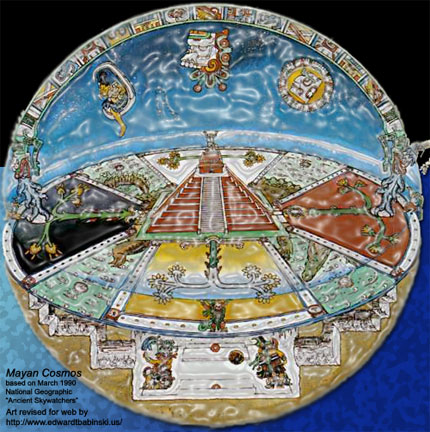Based on an excerpt from National Geographic, March 1990, Ancient Skywatchers

Pre-Columbian Americans left no definitive charts of the universe. Clues are in the iconography, ethnology and archaeology guided the reconstructions. Each of these cultures, the universe was encompassed by the sky, earth and an underworld. Each viewed celestial bodies as living beings that influenced man and could be affected by them. Each held the belief people came from the earth and dwelled in the center of the universe.
Mayan Cosmos
The universe of the Maya were centered on a tiered pyramid, and rest upon a crocodilian cosmic sea. Each quarter of the earth was associated with color, and the center of the earth was a “fifth direction”. Four sacred beings supported the dome of heaven, illustrated as a two-headed dragon, which had a body as a sky band of celestial symbols. It is arched over the moon goddess, who is holding the rabbit discerned in the moonʼs face, and a skeletal Venus, and the sun god. Pleides, is a star cluster and a rattlesnake tail. Creation of both sun and probably the planet Venus was explained with a legend of Hero twins who vied with the Lords of Death during a series of ball games. The victorious twins became these celestial bodies.
Navajo Cosmos
Navajo Cosmos
The Navajo Cosmos was portrayed as a sand painting, the world view of Diné— “the people,” as Navajo referred to themselves, centering on the family hogan. The first hogan was built in the place the ancestors emerged, and traveled through three previous words before arising from a hollow reed into this “glittering” place. The four quarters of the world is characterized with color, holy mountain, time of day, and a sacred person. The rainbow god is a guardian, and the sky sparkles with constellations (the Milky Way) symbolized by a band of crosses. Young warriors carry the blue sun and white moon. Beyond the sky is a land in which the Big Wind (yellow) and Big Thunder rule.
Inca Cosmos
Inca Cosmos
The king of the Inca believed he was the son of the sun, and the cosmos was centered on the Sun Temple at Cuzco, Peru. In one origin myth the Inca people came from three caves; in another myth they arose from Lake Titicaca. The straight red lines are ceques, symbolizing connections to sacred places. The major ceques formed borders of the four-quartered Inca world. The Milky Way blended into the underworld and brought dark, fertile mud to the sky upon its return, which formed patches that resemble animals, like the snake (at top) toad, tinamou bird, mother and baby llama, fox and a second tinamou. The sun is portrayed as a male god, and the moon as a female.
Original paintings by Ken Dallison, Principal Consultants; John B. Carlson, Center for Archaeoastronomy (Maya); Trudy Griffen-Pierce, University of Arizona (Navajo); Gary Urton, Colgate University (Inca).
Some years ago on primetime national television two television specials were featured on Noahʼs Ark and the other on the authenticity of biblical stories. In this documentary, the narrator explains how Babylonians, Egyptians, even some of the American Natives had mythologies of a “great flood” in the beginning… therefore…the inerrantist reasons, the story of Noahʼs flood must be true, and of course, all the ancient cultures based their story the same one found in the Bible.
Ancient cultures all shared like-beliefs in a flat earth and geocentric universe, too… so then we know what the Hebrews believed about the cosmos because they agreed on a massive flood… and the flat earth… and its place in a geocentric cosmos..


No comments:
Post a Comment